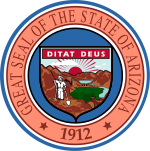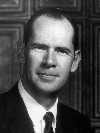
The 1970 United States Senate elections was an election for the United States Senate. It took place on November 3, with the 33 seats of Class 1 contested in regular elections. Special elections were also held to fill vacancies. These races occurred in the middle of Richard Nixon's first term as president. The Democrats lost a net of three seats, while the Republicans and the Conservative Party of New York picked up one net seat each, and former Democrat Harry F. Byrd Jr. was re-elected as an independent.

The 1968 United States Senate elections were elections for the United States Senate. Held on November 5, the 34 seats of Class 3 were contested in regular elections. They coincided with the presidential election of the same year. The Republicans picked up five net seats in the Senate. This saw Republicans win a Senate seat in Florida for the first time since Reconstruction.

The 1964 United States Senate elections were held on November 3. The 33 seats of Class 1 were contested in regular elections. Special elections were also held to fill vacancies. They coincided with the election of President Lyndon B. Johnson by an overwhelming majority, to a full term. His Democratic Party picked up a net two seats from the Republicans. As of 2022, this was the last time either party has had a two-thirds majority in the Senate, which would have hypothetically allowed the Senate Democrats to override a veto, propose constitutional amendments, or convict and expel certain officials without any votes from Senate Republicans. In practice, however, internal divisions effectively prevented the Democrats from doing so. The Senate election coincided with Democratic gains in the House in the same year.

From January 29 to June 4, 1996, voters of the Republican Party chose its nominee for president in the 1996 United States presidential election. Senator Bob Dole of Kansas, the former Senate majority leader, was selected as the nominee through a series of primary elections and caucuses culminating in the 1996 Republican National Convention held from August 12 to 15, 1996, in San Diego, California; Dole resigned from the Senate in June 1996 once he became the presumptive nominee to concentrate on his presidential campaign.

The 1952 United States Senate election in Arizona was held on November 4, 1952. Incumbent Democratic U.S. Senator and Senate Majority Leader Ernest McFarland ran for re-election to a third term, but was defeated by the Republican nominee and future candidate for President of the United States, Barry Goldwater.

The 2014 Arizona gubernatorial election was held on November 4, 2014, to elect the Governor of Arizona, concurrently with elections to the United States Senate in other states and elections to the United States House of Representatives and various state and local elections.
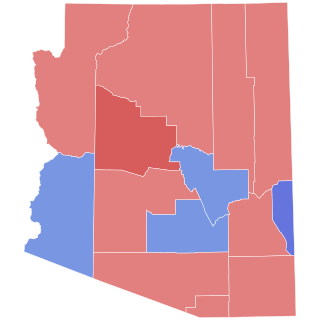
The 1958 United States Senate elections in Arizona took place on November 4, 1958. Incumbent Republican U.S. Senator Barry Goldwater ran for reelection to a second term, and defeated former U.S. Senator, and then-Governor, Ernest McFarland in the general election. The election was a rematch from 1952, where Goldwater defeated McFarland by a narrow margin. Goldwater had attributed the 1952 win to the unpopularity of President Harry S. Truman and popular Wisconsin Senator Joseph McCarthy endorsing his campaign.

The 1964 United States Senate election in Arizona took place on November 3, 1964. Incumbent Republican U.S. Senator Barry Goldwater decided not to run for reelection to a third term, instead running for President of the United States as the Republican Party nominee against Lyndon B. Johnson. Governor of Arizona Paul Fannin ran unopposed in the Republican primary, and defeated Democratic nominee Roy Elson, who was a staff member for U.S. Senator Carl Hayden until Hayden's retirement in 1969.
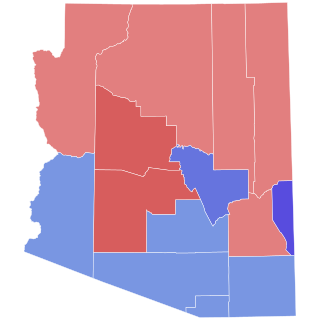
The 1970 United States Senate election in Arizona took place on November 3, 1970. Incumbent Republican U.S. Senator Paul Fannin decided to run for reelection to a second term, running unopposed in the Republican primary. Fannin defeated Democratic nominee Sam Grossman in the general election. This would be the last time until the Republican Revolution of 1994 that Republicans would win Arizona's Class 1 Senate Seat.

The 1974 United States Senate election in Arizona took place on November 5, 1974. Incumbent Republican U.S. Senator Barry Goldwater decided to run for reelection to a second consecutive term, after returning to the U.S. Senate in 1968 following his failed Presidential run in 1964 against Lyndon B. Johnson. Goldwater defeated Democratic Party nominee philanthropist Jonathan Marshall in the general election.
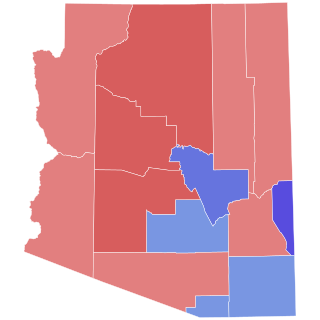
The 1968 United States Senate election in Arizona took place on November 5, 1968. Incumbent Democratic U.S. Senator Carl Hayden did not run for reelection to an eighth term, with his longtime staff member Roy Elson running as the Democratic Party nominee to replace him. Elson was defeated by a wide margin, however, by former U.S. Senator and 1964 Republican presidential nominee Barry Goldwater. Prior to Goldwater's election, the seat had been held for decades by the Democratic Party under Carl Hayden, but after this election remained in Republican Party control continuously for 52 years, until Democrat Mark Kelly won in the 2020 special election.

The 1962 United States Senate election in Arizona took place on November 6, 1962. Incumbent Democratic U.S. Senator Carl Hayden ran for reelection to a seventh term, defeating Republican State Senator Evan Mecham in the general election. Mecham became Governor of Arizona more than two decades later, and was subsequently impeached and removed from office.

The 1980 United States Senate election in Arizona took place on November 4, 1980. Incumbent Republican Senator Barry Goldwater decided to run for reelection to a third consecutive term, after returning to the Senate in 1968 following his failed presidential run in 1964 against Lyndon B. Johnson. Despite Republican presidential nominee Ronald Reagan's landslide win in Arizona, Goldwater defeated Democratic Party nominee Bill Schulz in the general election by a narrow margin, which later caused Goldwater to decide against running for reelection to a fourth consecutive term. Goldwater won only three counties, including Maricopa County.

The 1994 Arizona gubernatorial election took place on November 8, 1994, for the post of Governor of Arizona. Fife Symington, the incumbent Republican Governor of Arizona, defeated the Democratic nominee Eddie Basha to win a second term in office. However, Symington resigned in 1997 due to a federal indictment on corruption charges.

The 1978 Arizona gubernatorial election took place on November 7, 1978, for the post of Governor of Arizona. Democrat Bruce Babbitt defeated Republican nominee Evan Mecham. Babbitt was the former Attorney General of Arizona, but after the death of Governor Wesley Bolin, Babbit became governor. Bolin himself ascended to office from the position of Secretary of State, meaning his replacement, Rose Mofford was not eligible to the office as she was not elected. This drama of exchanging office would continue after Babbitt's term came to an end, as Mofford would become governor and succeeded Evan Mecham, Babbitt's challenger, in 1988.

The 1954 Arizona gubernatorial election took place on November 2, 1954. Incumbent Governor John Howard Pyle, the first Republican elected to the office in two decades, ran for reelection for a third term.

The 1958 Arizona gubernatorial election took place on November 4, 1958. Incumbent Governor Ernest McFarland decided not to run for reelection and instead unsuccessfully challenged U.S. Senator Barry Goldwater in attempt to return to the United States Senate.

The 1962 Arizona gubernatorial election took place on November 6, 1962. Incumbent Governor Paul Fannin ran for reelection against President of the Western Conference of United Funds Samuel Pearson Goddard in the general election, winning a third consecutive term, a first for a Republican Governor in Arizona. Fannin was sworn into his third term on January 1, 1963.

The 1974 Arizona gubernatorial election took place on November 5, 1974. Incumbent Governor Jack Williams decided not to run for a fourth term as governor. Former United States Ambassador to Bolivia Raúl Héctor Castro, who was the Democratic nominee in 1970, won the Democratic nomination again in 1974, and narrowly won the general election, defeating Republican nominee Russell Williams by 0.85%. Castro was sworn into his first and only term as governor on January 6, 1975.
William R. Schulz is an American businessman who was an Independent candidate for Governor of Arizona in the 1986 gubernatorial election, and was the Democratic nominee against Barry Goldwater in the 1980 U.S. Senate election.

